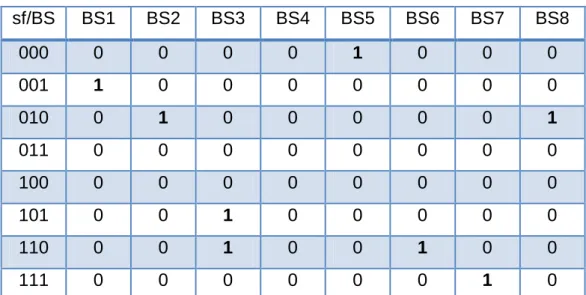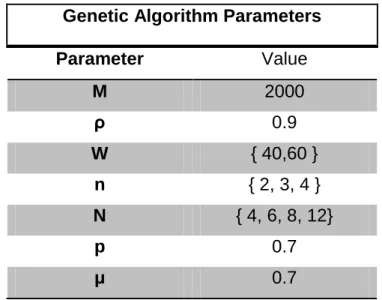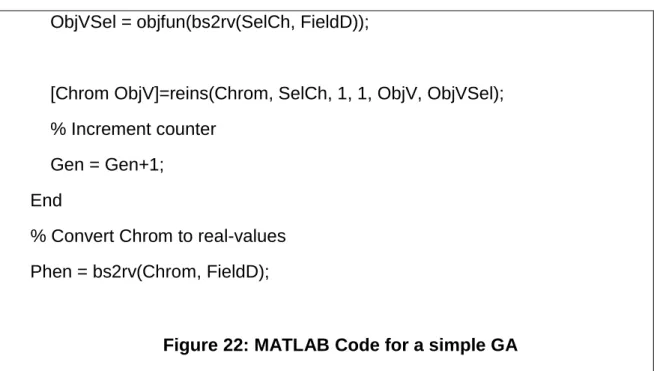INTRODUCTION
T HESIS O UTLINE
In addition, the MME is responsible for informing the HSS of the current location of the UE. Chiperfeld and P.J Fleming, “The Matlab Genetic Algorithm Toolbox”, in Proceedings of the IEE Coloquium on Applied Control Techniques Using MATLAB, pp.
BACKGROUND
H ISTORICAL R EVIEW
The first approaches of wireless telecommunication networks in the early 80s were analog (1G) and were replaced by digital approaches. In addition, the constant growth in the number of mobile subscribers and data transmission indicates the need for more advanced and efficient telecommunications networks with the latest and/or new technologies.
![Figure 1: Evolution of the telecommunication networks [25].](https://thumb-eu.123doks.com/thumbv2/pdfplayerco/331896.52624/16.892.168.705.791.1100/figure-1-evolution-telecommunication-networks-25.webp)
LTE
- Architecture
- IP Quality of Service (QoS) support
- Interfaces and Protocols
- Characteristics of LTE
To conclude in the UE domain, the most important thing is that the UE provides the user interface to the end user. First, it is the connecting bridge between the EPC (Evolved Packet Core) and the UE. The last function of the eNodeB is explained and analyzed in depth in the following chapters, which is the main focus of this thesis.
Furthermore, an authentication vector is requested from the EPC's Home Suscription Server (HSS). Mobility Management: The MME tracks the UE position either at the eNodeB level in active mode or at the Tracking Area (TA) level. It controls exclusively its own resources and allocates them at the request of the MME or the P-GW.
The S-GW plays an important role in active handover when the UE is in connected mode.
![Figure 2:The continuous growth of the subscribers using LTE and WiMAX over the recent years [26]](https://thumb-eu.123doks.com/thumbv2/pdfplayerco/331896.52624/18.892.129.784.112.420/figure-continuous-growth-subscribers-using-wimax-recent-years.webp)
K EY F UNCTIONALITIES AND T ECHNOLOGIES
- OFDMA
- MIMO
- Carrier Aggregation
- ARQ - HARQ
- Relay Nodes
In artificial intelligence, a genetic algorithm (GA) is a stochastic global search method that mimics the process of natural biological evolution [ 20 ]. With the first constraint in the optimization problem, Equation (2) assumes that certain base stations can be allocated once. Since the GA is running for a set of base stations, it is bound to believe that the base station scheduling is performed by a controller entity located in the LTE EPC.
Four different scenarios are evaluated here that increase the number of base stations in the system from 4 to 12 BS. Since the number of possible base station scheduling combinations grows with the number of base stations involved in the system, according to the Number of Bell [24], the number of base stations is kept relatively low in these experiments (up to 12).
![Figure 7: OFDMA depiction [30].](https://thumb-eu.123doks.com/thumbv2/pdfplayerco/331896.52624/31.892.132.800.105.397/figure-7-ofdma-depiction-30.webp)
PROBLEM DESCRIPTION
I NTRA - CELL INTERFERENCE
It is worth mentioning that the intra-cell interference problem has already been solved due to the use of OFDM. More specifically, the subcarriers of OFDM are orthogonal to each other, and this results in the solution of the problematic frequency selective fading.
I NTER - CELL INTERFERENCE
The fifth chapter presents an approach to mitigation by coordinating base station transmissions with genetic algorithms. Users, namely User Equipments (UEs) (according to the LTE specifications) experience a usable signal from the serving base station and interference signals from the other base stations in the network. Each element of this matrix is the binary decision variable indicating whether the base station will be subframed in the scheduling period.
In a real system, the planning map should be distributed to all base stations using a small binary map, similar to the string representation used in the GA search. Calculating the scheduling map is a periodic task that should follow the dynamics of interference levels found in the network.
![Figure 12: Cell edge user experiences high level of Interference [34].](https://thumb-eu.123doks.com/thumbv2/pdfplayerco/331896.52624/38.892.137.778.120.845/figure-cell-edge-user-experiences-high-level-interference.webp)
LITERATURE STUDY
F RACTIONAL F REQUENCY R EUSE
- Static FFR
- Dynamic FFR
On the other hand, cell edge users are defined as users who are close to the cell boundary and receive strong ICI from transmissions to other cells. There have been significant ongoing research efforts on dynamic FFR, ranging from game theoretic approach to graph-based dynamic FFR scheme [15-17]. The interference mitigation problem can be formulated as an interference graph in which UEs correspond to corresponding edges.
Such a problem is directly related to the graph coloring problem in which each color corresponds to a separate set of frequency sources. Each eNB then sends the necessary information to the central coordinator, which then generates the interference graph and performs the necessary optimization.
![Figure 15: Soft Freuncy Reuse (SFR) [35].](https://thumb-eu.123doks.com/thumbv2/pdfplayerco/331896.52624/41.892.133.772.585.914/figure-15-soft-freuncy-reuse-sfr-35.webp)
B EAMFORMING
The latter approach will be mentioned below as an example representing the dynamic FFR schemes. The goal is that each node in a graph is assigned a color in such a way that no connected nodes are assigned the same color. In [18] a centralized graph coloring approach is proposed, where a.
C OORDINATED M ULTI -P OINT (C O MP) TECHNIQUES
A phenotype corresponds to one or more string elements and one or more phenotypes encode a configuration component in the search space of the optimization problem. Each individual of the genetic algorithm search space is a scheduling map, represented as a binary matrix with subframe indexes in the rows and base stations in the columns. The scheduling information in the scheduling map matrix only 1 appears in that column).
Z is then associated with a fitness value in the range 0 to 2, where 2 is assigned to the best performing planning map (i.e., the fittest individual). In the present thesis, it is intended to evaluate how far the proposed solution is from the optimal case, when the number of generations is limited to a reasonable number M.
![Figure 17: Centralized CoMP technique [37].](https://thumb-eu.123doks.com/thumbv2/pdfplayerco/331896.52624/44.892.219.689.266.711/figure-17-centralized-comp-technique-37.webp)
GENETIC ALGORITHMS AND IMPLEMENTATION
I NTRODUCING THE G ENETIC A LGORITHMS
To achieve this result, new sets of solutions are created successively by the selected individuals, i.e. solutions, according to their fitness level in the problem domain and by the pairing of such individuals. The suitability of a solution is calculated from an objective function that characterizes an individual's performance in the problem domain. In the natural world, an individual's fitness will represent the adaptation to changes in its current environment.
It can be applied to any new chromosome and consists of changing one or more phenotypes according to a probabilistic rule. In this way, the average performance of individuals in a population is expected to increase, as strong individuals are retained in natural evolution and bred with each other while the less fit individuals become extinct.
P ROBLEM STATEMENT
Note that the first sum in the expression for throughput Z in equation (2) contains at most nonzero terms, and empty subframes can be eliminated, yielding scheduling map periods shorter than . The scheduling map is then defined as a matrix X of size , whose rows correspond to subframes, while columns correspond to base stations.
U SING A GENETIC ALGORITHM TO SEARCH THE SCHEDULING MAP
During pairing, recombination operators consider a single-point crossover with probability p and a single-bit mutation process with probability μ. Second, a single bit of each sibling generated by the crossover is chosen randomly (with a uniform distribution) and inverted with probability. A fraction of the offspring and a fraction of the parents survive, thus the population size remains stable with each new generation.
More specifically, the fittest children and the fittest parents will form the set of individuals that will mate in the next mating cycle. The entire process continues for M iterations, producing a final pollutant of W solutions, from which only the most suitable is selected and decoded as the actual scheduling map to be used in the system.

S CHEDULING MAP DISTRIBUTION
The first step is to start with a randomly generated set of W individuals that will be paired together. The generated offspring, consisting of W individuals, are evaluated only for the purpose of selecting the mapping solutions that give the higher throughput Z, as formulated in problem (2). Thus, in a mobile environment, it is reasonable to assume that a new scheduling map must be recomputed every few thousand frames, so that signaling messages should have a periodicity of about a few hundred milliseconds, which is comparable to the periodicity of other well-known signaling protocols for wireless network, such as the beacon interval for IEEE 802.11-based WLAN systems (sent every 100 ) or the wireless "hello".
P ERFORMANCE EVALUATION
However, a genetic algorithm-based search for the optimal base station scheduling map allows achieving near-optimal throughput results with limited computational complexity. Zhu, “Survey of Intercell Mitigation Techniques in LTE Downlink Networks,” in Proceedings of the Australasian Telecommunication Networks and Applications Conference (ATNAC), p. 15th Asia Pacific Conference on Communications (APCC 2009), p.
Kuo, "A graph-based approach to multi-cell OFDMA downlink resource allocation", in Proceedings of the IEEE Global Telecommunication Conference (GLOBECOM "08), pp. Fractional frequency reuse in multi-cell OFDMA networks", in Proceedings of the IEEE International Conference on Communication (ICC „09), pp.

CONCLUSION AND FUTURE WORK
C ONCLUSION
Encouraged by the excessive emergence of 4G networks, this thesis focuses on long-term development and its improvements. It is also intended to improve fairness between users and reduce system-wide delays. One of the obstacles that causes considerable problems is the so-called inter-cellular interference.
This means that in an LTE network, even the neighboring base stations must transmit to all source blocks simultaneously, causing high levels of interference for the users and, more generally, degrading the performance of the network. Due to the very wide range of existing techniques, this thesis refers to some of them for the sake of example.
F UTURE W ORK
Stations to Mitigate Interferences in Cellular Networks”, Technical Report, University Carlos III of Madrid, IMDEA Networks, Madrid, 2012. 24] S.S Wagstaff Jr., “Aurifeuillian factorizations and the period of the bell numbers modulo a prime”, Mathematics of Computation , ISSN vol. A brief description of the figure's code is given below, which is based on the MATLAB implementation of this thesis.
These are the number and length of chromosomes, the crossover and mutation rates, the number of generations, and the binary representation scheme. Plotgraphics displays the performance of the current best controller, allowing the user to assess the status of the search.
